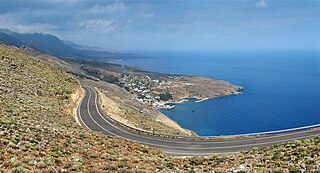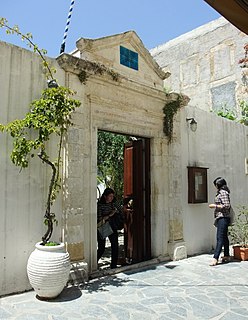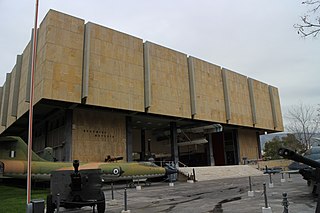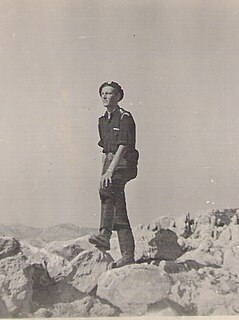
Crete is the largest and most populous of the Greek islands, the 88th largest island in the world and the fifth largest island in the Mediterranean Sea, after Sicily, Sardinia, Cyprus, and Corsica. Crete rests approximately 160 km (99 mi) south of the Greek mainland. It has an area of 8,336 km2 (3,219 sq mi) and a coastline of 1,046 km (650 mi). It bounds the southern border of the Aegean Sea, with the Sea of Crete to the north and the Libyan Sea to the south.

Chania is a city in Greece and the capital of the Chania regional unit. It lies along the north west coast of the island Crete, about 70 km (43 mi) west of Rethymno and 145 km (90 mi) west of Heraklion.

Heraklion or Iraklion is the largest city and the administrative capital of the island of Crete and capital of Heraklion regional unit. It is the fourth largest city in Greece with a population of 211,370 according to the 2011 census. The population of the municipality was 173,993.

The Battle of Crete was fought during the Second World War on the Greek island of Crete. It began on the morning of 20 May 1941, when Nazi Germany began an airborne invasion of Crete. Greek and other Allied forces, along with Cretan civilians, defended the island. After one day of fighting, the Germans had suffered heavy casualties and the Allied troops were confident that they would defeat the invasion. The next day, through communication failures, Allied tactical hesitation, and German offensive operations, Maleme Airfield in western Crete fell, enabling the Germans to land reinforcements and overwhelm the defensive positions on the north of the island. Allied forces withdrew to the south coast. More than half were evacuated by the British Royal Navy and the remainder surrendered or joined the Cretan resistance. The defence of Crete evolved into a costly naval engagement; by the end of the campaign the Royal Navy's eastern Mediterranean strength had been reduced to only two battleships and three cruisers.

The history of Crete goes back to the 7th millennium BC, preceding the ancient Minoan civilization by more than four millennia. The palace-based Minoan civilization was the first civilization in Europe.

Eleftherios Kyriakou Venizelos was a Greek statesman and a prominent leader of the Greek national liberation movement. He is noted for his contribution to the expansion of Greece and promotion of liberal-democratic policies. As leader of the Liberal Party, he was elected eight times as Prime Minister of Greece, serving from 1910 to 1920 and from 1928 to 1933. Venizelos had such profound influence on the internal and external affairs of Greece that he is credited with being "The Maker of Modern Greece", and is still widely known as the "Ethnarch".

Sfakiá is a mountainous area in the southwestern part of the island of Crete, in the Chania regional unit. It is considered to be one of the few places in Greece that have never been fully occupied by foreign powers. With a 2011 census population of 1,889 inhabitants living on a land area of 467.589 km2 (180.537 sq mi), Sfakia is one of the largest and least densely populated municipalities on the island of Crete. The etymology of its name is disputed. According to the prevailing theory, it relates to its rugged terrain, deriving from the ancient Greek word σφαξ, meaning land chasm or gorge.

Gortyna was a town of ancient Crete which appears in the Homeric poems under the form of Γορτύν; but afterwards became usually Gortyna (Γόρτυνα). According to Stephanus of Byzantium it was originally called Larissa (Λάρισσα) and Cremnia or Kremnia (Κρήμνια).
Kydonia or Cydonia was an ancient city-state on the northwest coast of the island of Crete. It is at the site of the modern-day Greek city of Chania. In legend Cydonia was founded by King Cydon (Κύδων), a son of Hermes or Apollo and of Akakallis, the daughter of King Minos. According to Pausanias he was son of king Tegeates.

Souda Bay is a bay and natural harbour near the town of Souda on the northwest coast of the Greek island of Crete. The bay is about 15 km long and only two to four km wide, and a deep natural harbour. It is formed between the Akrotiri peninsula and Cape Drapano, and runs west to east. The bay is overlooked on both sides by hills, with a relatively low and narrow isthmus in the west near Chania.

Kissamos is a town and a municipality in the west of the island of Crete, Greece. It is part of the Chania regional unit and of the former Kissamos Province which covers the northwest corner of the island. The town of Kissamos is also known as Kastelli Kissamou and often known simply as Kastelli after the Venetian castle that was there. It is now a port and fishing harbour, with a regular ferry from the Peloponnese via Kythira. A town museum is located in the old Venetian governor's palace and there have been important archaeological finds in the town, including fine mosaics, dating from the Roman city of Kisamos. The head town of the municipality is Kastelli-Kissamos itself.

The Etz Hayyim Synagogue is an Orthodox Jewish synagogue in Chania on the Greek island of Crete. It is the only surviving remnant of the island's Romaniote Jewish community.

The Athens War Museum, established on July 18, 1975, is the museum of the Greek Armed Forces. Its purpose is the exhibition of weapon artifacts and the relevant research in the history of war. It covers the history of war in all ages. The museums' collections include the collection of the Greek Army, with artifacts from other civilizations such as Ancient China and Ancient Japan. In 1964, the Hellenic State decided to found the War Museum, wishing to honor all those who fought for Greece and its freedom. The design of the museum was undertaken by a team of distinguished scientists, headed by Professor Thoukidides Valentis of the National Technical University of Athens (N.T.U.A). On July 18, 1975, the President of the Hellenic Republic H.E. Constantine Tsatsos and the Minister of National Defense Evangelos Averoff-Tositsas inaugurated the museum. Its various activities include the publication of books, the establishment and maintenance of monuments and memorials and the aid to services and agencies all over Greece. The Museum's exhibition areas are distributed over four levels (floors) and present images of Greek history from antiquity to the present. The museum's centerpieces are weaponry from wars in which Greece was involved.

The Cretan State was established in 1898, following the intervention by the Great Powers on the island of Crete. In 1897, the Cretan Revolt led the Ottoman Empire to declare war on Greece, which led United Kingdom, France, Italy and Russia to intervene on the grounds that the Ottoman Empire could no longer maintain control. It was the prelude to the island's final annexation to the Kingdom of Greece, which occurred de facto in 1908 and de jure in 1913 after the First Balkan War.

The Archaeological Museum of Chania is a museum that was located in the former Venetian Monastery of Saint Francis at Chalidon Street, Chania, Crete, Greece. It was established in 1962. In 2020 this location closed and the museum will be relocated to a new building in Halepa with reopening scheduled for June 2021.

The Nautical Museum of Crete is a museum in Chania, Crete, Greece. Its collection includes models of ships, nautical instruments, painting, historical photographs and war relics. The material is classified chronologically, starting from the Bronze Age up to our times.

Kastelli Hill is a landform at the city of Chania on the island of Crete in the present day country of Greece. The Minoan city of ancient Cydonia was centered on Kastelli Hill, which later was selected by the Romans as the site of an acropolis.

The Damasta sabotage was an attack by Cretan resistance fighters led by British Special Operations Executive officer Captain Bill Stanley Moss MC against German occupation forces in World War II. The attack occurred on 8 August 1944 near the village of Damasta and was aimed to prevent the Germans from assaulting the village of Anogeia.
Konstantinos Th. Bakopoulos (1889–1950) was a Greek General in the Hellenic Army who took part in the Balkan Wars (1912–3), played a crucial conciliatory role in Greek military politics during the 1930s and distinguished himself in the fight against the Nazis during World War II. In 1943 he was imprisoned in German concentration camps until the end of the war in 1945.

The Presentation of the Virgin Mary Holy Metropolitan Church is a Greek Orthodox cathedral, located in Athinagora Square in the old town of Chania in Crete .It was originally built during the late period of Ottoman rule, between 1850 and 1860.

















